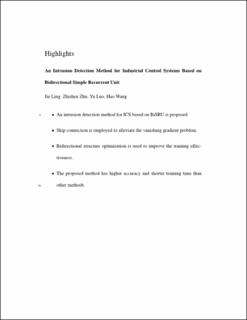| dc.contributor.author | Ling, Jie | |
| dc.contributor.author | Zhu, Zhishen | |
| dc.contributor.author | Luo, Yu | |
| dc.contributor.author | Wang, Hao | |
| dc.date.accessioned | 2021-03-23T08:23:16Z | |
| dc.date.available | 2021-03-23T08:23:16Z | |
| dc.date.created | 2021-03-21T16:31:00Z | |
| dc.date.issued | 2021 | |
| dc.identifier.citation | Computers & electrical engineering. 2021, 91, . | en_US |
| dc.identifier.issn | 0045-7906 | |
| dc.identifier.uri | https://hdl.handle.net/11250/2734956 | |
| dc.description.abstract | With the development of computer and network technologies, the original security of industrial control systems (ICSs) has been compromised, and security issues have become increasingly prominent. Effective intrusion detection methods for ICSs have been proposed. Recently, intrusion detection methods based on deep learning, such as long short-term memory and gated recurrent units, have immensely improved the detection accuracy compared with traditional methods. However, there are still problems that remain to be solved, such as vanishing gradient and low training efficiency. Therefore, this study proposed an intrusion detection method based on a bidirectional simple recurrent unit (BiSRU). With skip connections employed, the optimized bidirectional structure in the SRU neural network is able to alleviate the vanishing gradient problem and improve the training effectiveness. Two standard industrial datasets from Mississippi State University are used in the simulation. The results show that the proposed method is more accurate and requires less training time than other methods. | en_US |
| dc.language.iso | eng | en_US |
| dc.publisher | Elsevier | en_US |
| dc.rights | Attribution-NonCommercial-NoDerivatives 4.0 Internasjonal | * |
| dc.rights.uri | http://creativecommons.org/licenses/by-nc-nd/4.0/deed.no | * |
| dc.title | An intrusion detection method for industrial control systems based on bidirectional simple recurrent unit | en_US |
| dc.type | Peer reviewed | en_US |
| dc.type | Journal article | en_US |
| dc.description.version | acceptedVersion | en_US |
| dc.source.volume | 91 | en_US |
| dc.source.journal | Computers & electrical engineering | en_US |
| dc.identifier.doi | 10.1016/j.compeleceng.2021.107049 | |
| dc.identifier.cristin | 1899692 | |
| dc.description.localcode | © 2021. This is the authors’ accepted and refereed manuscript to the article. Locked until 9 March 2023 due to copyright restrictions. This manuscript version is made available under the CC-BY-NC-ND 4.0 license http://creativecommons.org/licenses/by-nc-nd/4.0/ | en_US |
| dc.source.articlenumber | 107049 | en_US |
| cristin.ispublished | true | |
| cristin.fulltext | postprint | |
| cristin.qualitycode | 1 | |

